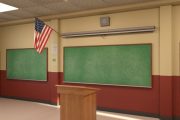
A recently released report from the Educational Testing Service (ETS) indicated that American “millennials” (those born after 1980 who were 16 to 34 years of age at the time of the study) scored near the bottom of the pack among 23 countries evaluated for various skills.
Researchers at Princeton-based ETS tested those born in the last two decades of the last century in skills including literacy, technology problem solving, and numeracy (mathematical skills). The ETS report was the first to use data from the Program for the International Assessment of Adult Competencies (PIAAC), a study that was developed under the auspices of the Paris-based Organization for Economic Cooperation and Development (OECD). The Preface to the report made a statement that many found surprising:
Despite having the highest levels of educational attainment of any previous American generation, these young adults on average demonstrate relatively weak skills in literacy, numeracy, and problem solving in technology-rich environments compared to their international peers.
In comparing the performance of U.S. participants with those from other countries, the report noted these rankings:
• Literacy: U.S. millennials place 17th out of 23 participating countries. Only millennials in Spain and Italy had lower scores.
• Numeracy: U.S. millennials ranked 21st and tied for last place with Italy and Spain.
• PS-TRE (Problem Solving, Technology-Rich Environments): U.S. millennials ranked 18th and tied for last place, along with the Slovak Republic, Ireland, and Poland.
Japan ranked first and Finland ranked second in all categories. American millennials with four-year college degrees received test scores comparable with those having only high school diplomas in Finland, Japan, and the Netherlands.
Casting a somewhat pessimistic outlook, the report’s authors noted several factors that reflect poorly on the products of the American education system. They noted that by targeting those in the millennial generation, their study included “the most recent products of our educational systems.” Furthermore, recent reports suggested that this group of Americans had “attained the most years of schooling of any cohort in American history.” Finally, the performance of this age group is important because “millennials will shape the economic and social landscape of our country for many years to come.”
The report also refutes the common assumption that merely completing a number of years of higher education automatically confers a high level of proficiency. Its findings, note the authors:
Offer a clear caution to anyone who believes that our policies around education should focus primarily on years of schooling or trusts that the conferring of credentials and certificates alone is enough. While it is true that, on average, the more years of schooling one completes, the more skills one acquires, this report suggests that far too many are graduating high school and completing postsecondary educational programs without receiving adequate skills.
The report noted that since 2003, the percentages of U.S. millennials scoring below level 3 in numeracy (the minimum standard) increased at all levels of educational attainment.
The significance of this report is underscored by statistical studies conducted by Pew Research indicating that sometime during this year, the number of millennials in our population will exceed the number of Baby Boomers (those born between 1946 and 1964). (The former is increasing due to immigration and the latter decreasing because of deaths.)
Those at ETS who conducted the study were surprised not only at how poorly U.S. millennials did in comparison with those in other countries, but also compared with Americans in preceding generations. “We really thought [U.S.] Millennials would do better than the general adult population, either compared to older coworkers in the U.S. or to the same age group in other countries,” Madeline Goodman, an ETS researcher who worked on the study, was quoted by Fortune. “But they didn’t. In fact, their scores were abysmal.”
While U.S. millennials with college degrees managed to score higher on the survey than Americans with only a high school diploma, Goodman concluded that “a degree may not be enough” to prove that an individual is proficient in basic English, can perform skills employing “workaday math,” or is able to use technology in a job.
While Goodman and others may have been surprised by the findings of ETS’s research, they probably shouldn’t have been, since U.S. educational standards have been in decline for decades. When Rudolf Flesch published his ground-breaking work Why Johnny Can’t Read — And What You Can Do About It in 1955, he started a national debate. His book was critical of the practice of teaching reading by sight (the “look-say” method) and advocated a revival of the phonics method of teaching students to sound out words.
The critique of American education was continued by a long-time contributor to The New American, Samuel L. Blumenfeld, who has spent much of his career researching and writing about the decline in American literacy, and has authored 10 books on education, including N.E.A.: Trojan Horse in American Education, Alpha-Phonics: A Primer For Beginning Readers, and Is Public Education Necessary?
Blumenthal explored the reasons why Americans schoolchildren fared poorly in comparison with their international counterparts in a four-part series of articles for The New American last December through January, “Who Are the World’s Smartest Kids? Not Americans.” In his final article Blumenfeld noted that in 2013, he wrote a letter to former Florida Governor Jeb Bush advising him that the simplest and most direct way to improve American education would be to get rid of the prevalent sight method of teaching reading. Blumenfeld maintains: “If every child in America were taught to read with intensive, systematic phonics, this would create literate students who could read anything and would thereby demand substance to their education.”
Of course, as the ETS study reveals, Americans have problems even beyond reading skills, and did poorly in math and technical skills, as well. In Part 3 of his series, Blumenfeld addressed our failures in math and science. He related the story of a student from Pennsylvania named Tom who went to a school in Poland and was overwhelmed by the tough math curriculum in that country. Blumenfeld wrote:
As the days passed, Tom noticed the difference between how math was being taught in Pennsylvania and in Poland. In the United States, Tom and his fellow students all used calculators. But in his Polish class, calculators were not permitted. Polish kids were doing a lot of math in their heads. Apparently, Polish educators understood that arithmetic is a system that requires memorization for its efficient use. But in the United States, progressive educators had banned rote memorization, considering it to be a form of child abuse.
Much has been written about the factors contributing to the deficiencies in the American educational system responsible for the poor results reflected in the recent ETS study. The conclusion reached by Blumenfeld and other advocates of a disciplined, traditional education program is that we are suffering from more than a century of the system of “progressive” education advocated by John Dewey and his colleagues. This change in our educational methods did not come about overnight. Dewey outlined a plan to implement his progressive agenda in an essay written in 1898, “The Primary-Education Fetish.”
Since Japanese millennials came out on top in all three categories surveyed by ETS, a good place to begin improving our educational system might be to take a look at Japanese educational methods and determine what they are doing right that we are doing wrong.
Related articles:
Education Expert Says College Freshmen Read at Seventh-grade Level
Fifty Years of Title 1: Has It Worked?
Common Core Is Rotten to the Core
OECD: U.S. Schools Mediocre on Education Compared to World
Who Are the World’s Smartest Kids? Not Americans
Who Are the World’s Smartest Kids? Part 2
Who Are the World’s Smartest Kids? Part 3
Who Are the World’s Smartest Kids? Part 4




